


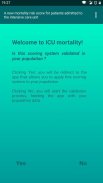
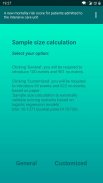
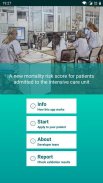
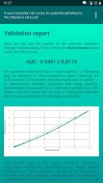
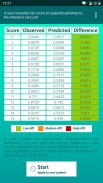

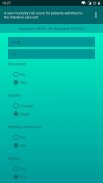

ICU Mortality

Description of ICU Mortality
This mobile App is a medical calculator indicating the likelihood that a patient admitted to the ICU will die during admission.
To calculate this likelihood we need to know the following patient parameters: medical admission [yes or no (surgical admission)], sepsis (yes or no), inotropic support (yes or no), cardiology admission (yes or no), mechanical ventilation (yes or no) and function scale (independent, dependent or disability).
To provide this likelihood the App will calculate a total score based on the risk afforded by the above parameters. A patient will have a greater risk of death if he or she has a medical or cardiology admission, has inotropic support, mechanical ventilation, sepsis or a higher degree of dependence. According to the score obtained, the patient will have a probability associated with death.
More details about the development of the risk score are given in the following scientific publications:
1. Dólera-Moreno C, Palazón-Bru A, Colomina-Climent F, Gil-Guillén VF. Construction and internal validation of a new mortality risk score for patients admitted to the intensive care unit. Int J Clin Pract 2016;70:916-922. doi: 10.1111/ijcp.12851.
2. Palazón-Bru A, Dólera-Moreno C, Folgado-de la Rosa DM, Colomina-Climent F, Gil-Guillén VF. An update to the internal validation of the new mortality risk score for patients admitted to the intensive care unit. Int J Clin Pract 2016;70:961-962. doi: 10.1111/ijcp.12897.
Nonetheless, as with predictive models, this score must be validated externally for use in other populations before its implementation in daily clinical practice. To carry out this process, both discrimination and calibration must be examined. Discrimination consists of determining whether a higher score can differentiate between those subjects who will die and those who will not. This should be assessed by calculating the area under the ROC curve. Calibration involves analyzing whether the event probabilities predicted by the model correspond to those observed in reality. This process is preferably performed using smooth calibration plots based on splines or loess. In addition, the validation must be assessed using an optimum statistical technique, such as bootstrapping.
Another point to be considered is the sample size to perform the validation process. Two approaches have been published. The first requires at least 100 events (deaths), regardless of the predictive model being addressed, and the second is a specific algorithm for each scoring system. More details about this second method are given in:
1.Palazón-Bru A, Folgado-de la Rosa DM, Cortés-Castell E, López-Cascales MT, Gil-Guillén VF. Sample size calculation to externally validate scoring systems based on logistic regression models. PLoS One 2017;12:e0176726. doi: 10.1371/journal.pone.0176726.
Using the latter approach for the scoring system concerning ICU mortality, we would need at least 69 deceased patients.
Taking into account all of these points, this mobile app performs the external validation process, determining discrimination and smooth calibration (splines) through bootstrapping. The patient data is entered, and once the sample size has been reached (either of the two approaches maybe chosen), the app will start the calculations. Finally, a report will be generated and sent by email (attached with your data set), explaining the obtained results. However, if you have previously validated the scoring system, you can calculate the risk directly without carrying out the validation process.
A scientific paper is in process in which we will give more information about the mobile App.
IMPORTANT NOTE: This application only gives probabilities. Although it is impossible to know the certain prognosis of a patient, this calculator gives us an approximation (if validated correctly). Clinical decisions must always be made by physicians. The authors will not be held responsible for decisions made using this application.


























